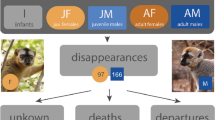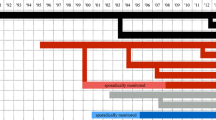Abstract
As in other highly sexually dimorphic, group-living animals, reproduction in gorillas has been largely viewed as the outcome of competition among males. However, females may exert choice via dispersal decisions or choice of partner in multimale groups, and males may also mate selectively. Here, we examine the paternity of 79 wild mountain gorilla offspring born into four groups characterized by stable dominance hierarchies and the presence of mature offspring of the dominant male. We found that on average the dominant male sires the majority (72 %) of the offspring in stable multimale groups and subordinate males also produce offspring, particularly when dominant males become older or the number of competing males increases. Although expected to disperse to avoid inbreeding, only half of the maturing daughters of dominant males left the group in which their father maintained dominance. However, in all five cases of reproduction by a resident daughter of a dominant male, a subordinate male was the sire of the offspring. As females commonly initiate and end copulations, and dominant males may prefer mating with fully mature females, both male and female mate preferences in addition to male competition apparently play a role in reproductive patterns in multimale groups, emphasizing the complexity of social dynamics in one of our closest living relatives.

Similar content being viewed by others
References
Alberts SC (1999) Paternal kin discrimination in wild baboons. Proc R Soc Lond B 266:1501–1506
Altmann SA (1962) A field study of the sociobiology of the rhesus monkey, Macaca mulatta. Ann N Y Acad Sci 102:338–435
Altmann J, Alberts SC, Haines SA et al (1996) Behavior predicts genetic structure in a wild primate group. Proc Natl Acad Sci U S A 93:5797–5801
Bates D, Maechler M, Bolker B, Walker S (2013) lme4: linear mixed-effects models using Eigen and S4. R package version1.0-5, http://CRAN.Rproject.org/package=lme4
Boesch C, Kohou G, Nene H, Vigilant L (2006) Male competition and paternity in wild chimpanzees of the Tai forest. Am J Phys Anthropol 130:103–115
Bradley AP (1997) The use of the area under the roc curve in the evaluation of machine learning algorithms. Pattern Recogn 30:1145–1159
Bradley BJ, Doran-Sheehy DM, Lukas D, Boesch C, Vigilant L (2004) Dispersed male networks in western gorillas. Curr Biol 14:510–513
Bradley BJ, Robbins MM, Williamson EA, Steklis HD, Steklis NG, Eckhardt N, Boesch C, Vigilant L (2005) Mountain gorilla tug-of-war: silverbacks have limited control over reproduction in multimale groups. Proc Natl Acad Sci U S A 102:9418–9423
Caillaud D, Ndagijimana F, Vecellio V, Stoinski TS (2013) Individual and group level factors shape the social sphere of individual mountain gorillas (Gorilla b. beringei). Am J Phys Anthropol 150:92
Clutton-Brock TH (1989) Female transfer and inbreeding avoidance in social mammals. Nature 337:70–72
Clutton-Brock TH, Lukas D (2012) The evolution of social philopatry and dispersal in female mammals. Mol Ecol 21:472–492
Clutton-Brock TH, Parker GA (1995) Sexual coercion in animal societies. Anim Behav 49:1345–1365
Dobson SF (1982) Competition for mates and predominant juvenile male dispersal in mammals. Anim Behav 30:1183–1192
Gray M, Roy J, Vigilant L, Fawcett K et al (2013) Genetic census reveals increased but uneven growth of a critically endangered mountain gorilla population. Biol Conserv 158:230–238
Harcourt AH, Stewart KJ (2007) Gorilla society: what we know and don’t know. Evol Anthropol 16:147–158
Harcourt AH, Harvey PH, Larson SG, Short RV (1981) Testis weight, body weight and breeding system in primates. Nature 293:55–57
Hoelzel AR, Le Boeuf BJ, Reiter J, Campagna C (1999) Alpha-male paternity in elephant seals. Behav Ecol Sociobiol 46:298–306
Honer OP, Wachter B, East ML, Streich WJ, Wilhelm K, Burke T, Hofer H (2007) Female mate-choice drives the evolution of male-biased dispersal in a social mammal. Nature 448:798–801
Kalinowski ST, Taper ML, Marshall TC (2007) Revising how the computer program CERVUS accommodates genotyping error increases success in paternity assignment. Mol Ecol 16:1099–1106
Kuester J, Paul A, Arnemann J (1994) Kinship, familiarity and mating avoidance in barbary macaques, Macaca sylvanus. Anim Behav 48:1183–1194
Kutsukake N, Nunn C (2006) Comparative tests of reproductive skew in male primates: the roles of demographic factors and incomplete control. Behav Ecol Sociobiol 60:695–706
Lukas D, Clutton-Brock TH (2011) Group structure, kinship, inbreeding risk and habitual female dispersal in plural-breeding mammals. J Evol Biol 24:2624–2630
Muller MN, Thompson ME, Wrangham RW (2006) Male chimpanzees prefer mating with old females. Curr Biol 16:2234–2238
Muniz L, Perry S, Manson JH, Gilkenson H, Gros-Louis J, Vigilant L (2006) Father-daughter inbreeding avoidance in a wild primate population. Curr Biol 16:R156–R157
Ortega J, Maldonado JE, Wilkinson GS, Arita HT, Fleischer RC (2003) Male dominance, paternity, and relatedness in the Jamaican fruit-eating bat (Artibeus jamaicensis). Mol Ecol 12:2409–2415
Paul A, Kuester J, Timme A, Arnemann J (1993) The association between rank, mating effort, and reproductive success in male Barbary macaques (Macaca sylvanus). Primates 34:491–502
Pusey AE (1987) Sex-biased dispersal and inbreeding avoidance in birds and mammals. Trends Ecol Evol 2:295–299
R Core Team (2014) R: a language and environment for statistical computing. R Foundation for Statistical Computing, Vienna, Austria, http://www.R-project.org/
Robbins MM (1999) Male mating patterns in wild multimale mountain gorilla groups. Anim Behav 57:1013–1020
Robbins AM, Robbins MM (2005) Fitness consequences of dispersal decisions for male mountain gorillas (Gorilla beringei beringei). Behav Ecol Sociobiol 58:295–309
Robbins AM, Stoinski T, Fawcett K, Robbins MM (2009) Leave or conceive: natal dispersal and philopatry of female mountain gorillas in the Virunga volcano region. Anim Behav 77:831–838
Robbins AM, Gray M, Basabose A, Uwingeli P, Mburanumwe I, Kagoda E, Robbins MM (2013) Impact of male infanticide on the social structure of mountain gorillas. PLoS ONE 8, e78256
Rosenbaum S, Silk JB, Stoinski TS (2011) Male-immature relationships in multi-male groups of mountain gorillas (Gorilla beringei beringei). Am J Primatol 73:356–365
Setchell JM, Charpentier M, Wickings EJ (2005) Mate guarding and paternity in mandrills: factors influencing alpha male monopoly. Anim Behav 70:1105–1120
Silk JB (2009) Nepotistic cooperation in non-human primate groups. Philos T Roy Soc B 364:3243–3254
Sing T, Sander O, Beerenwinkel N, Lengauer T (2005) ROCR: visualizing classifier performance in R. Bioinformatics 21:3940–3941
Stoinski TS, Perdue BM, Legg AM (2009a) Sexual behavior in female western lowland gorillas (Gorilla gorilla gorilla): evidence for sexual competition. Am J Primatol 71:587–593
Stoinski TS, Vecellio V, Ngaboyamahina T, Ndagijimana F, Rosenbaum S, Fawcett KA (2009b) Proximate factors influencing dispersal decisions in male mountain gorillas, Gorilla beringei beringei. Anim Behav 77:1155–1164
Strier KB, Chaves PB, Mendes SL, Fagundes V, Di Fiore A (2011) Low paternity skew and the influence of maternal kin in an egalitarian, patrilocal primate. Proc Natl Acad Sci U S A 108:18915–18919
Stumpf RM, Boesch C (2010) Male aggression and sexual coercion in wild West African chimpanzees, Pan troglodytes verus. Anim Behav 79:333–342
Trivers RL (1972) Parental investment and sexual selection. In: Campbell B (ed) Sexual selection and the descent of man, 1871-1971. Aldine-Atherton, Chicago, pp 136–179
Watts DP (1990) Mountain gorilla life histories, reproductive competition, and sociosexual behavior and some implications for captive husbandry. Zoo Biol 9:185–200
Wickings EJ, Bossi T, Dixson AF (1993) Reproductive success in the mandrill, Mandrillus sphinx: correlations of male dominance and mating success with paternity, as determined by DNA fingerprinting. J Zool 231:563–574
Wolff JO (1994) More on juvenile dispersal in mammals. Oikos 71:349–352
Wroblewski EE, Murray CM, Keele BF, Schumacher-Stankey JC, Hahn BH, Pusey AE (2009) Male dominance rank and reproductive success in chimpanzees, Pan troglodytes schweinfurthii. Anim Behav 77:873–885
Xue Y, Prado-Martinez J, Sudmant PH et al (2015) Mountain gorilla genomes reveal the impact of long-term population decline and inbreeding. Science 348:242–245
Acknowledgments
We gratefully acknowledge the Rwandan Government and National Park authorities for their long-term commitment to gorilla conservation and support of the Karisoke Research Center. The authors express their gratitude to the many Karisoke field assistants and researchers who painstakingly gathered the decades of demographic and genetic data used in this study, and in particular V. Vecellio and F. Ndagijimana for their work in coordinating these efforts. We thank C. Lang and A. Abraham for contributing to the laboratory analyses, M. Schreiber for drawing the figure, and D. Lukas and A. Robbins for discussion. This research was financially supported by the Max Planck Society. The Dian Fossey Gorilla Fund International (DFGFI) also gratefully acknowledges the public and private agencies, foundations, and individuals that have provided support for the Karisoke Research Center (see www.gorillafund.org for a list of supporters).
Ethical standards
All research complied with the laws of the countries in which it was performed.
Author information
Authors and Affiliations
Corresponding author
Additional information
Communicated by R. I. M. Dunbar
Rights and permissions
About this article
Cite this article
Vigilant, L., Roy, J., Bradley, B.J. et al. Reproductive competition and inbreeding avoidance in a primate species with habitual female dispersal. Behav Ecol Sociobiol 69, 1163–1172 (2015). https://doi.org/10.1007/s00265-015-1930-0
Received:
Revised:
Accepted:
Published:
Issue Date:
DOI: https://doi.org/10.1007/s00265-015-1930-0




